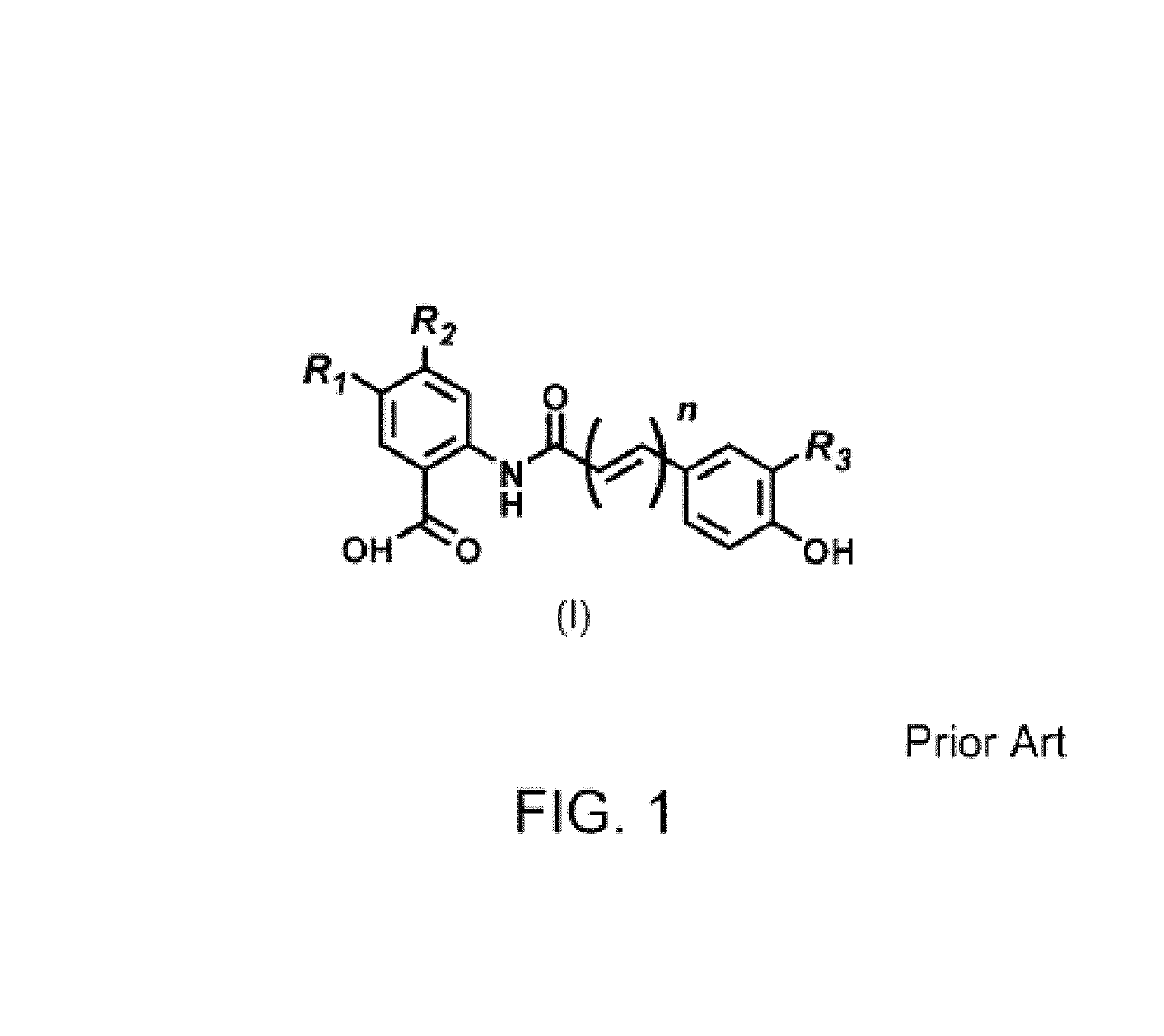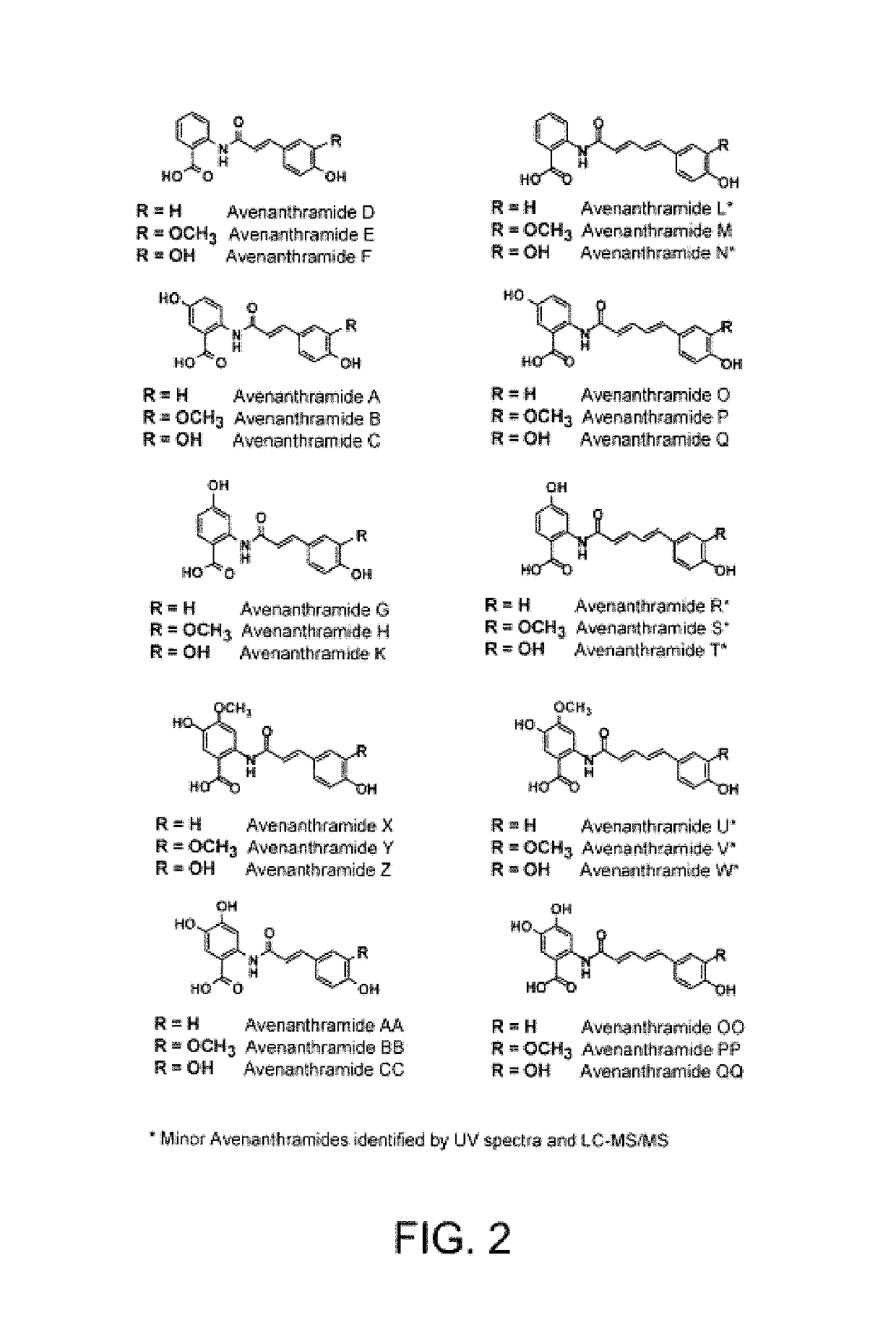Method for increasing concentration of avenanthramides in oats
a technology of avenanthramides and oats, which is applied in the field of avenanthramides, can solve the problems of not producing malted products with sufficiently high levels of avenanthramides to elicit the desired physiological responses, compromising the integrity of the intact kernel, and limited use of sprouted products in any further dry fractionation/milling application, etc., to achieve the effect of increasing the concentration of avenanthramid
- Summary
- Abstract
- Description
- Claims
- Application Information
AI Technical Summary
Benefits of technology
Problems solved by technology
Method used
Image
Examples
example 1
s. Non-Dormant Oats
[0082]Seed samples of a freshly harvested dormant, hulless, bald seeded oat breeding line (VAO-48) and those of a non-dormant, hulless, bald seeded oat breeding line (VAO-2, now registered as variety AC GEHL) were malted as described below.
[0083]Approximately 20 g of each breeding line were briefly surface sterilized by immersion in aqueous 1% sodium hypochlorite solution for 20 min at room temperature with gentle agitation then removed and thoroughly rinsed to eliminate excess sodium hypochlorite solution. The seeds were then germinated in covered Petri dishes (150×15 mm) on moist filter paper disks at room temperature and diffuse light for 4 days. A separate sample of 20 g of each breeding line was set aside as a control.
[0084]After four days the germination rates of the two samples were determined. The seeds, including both germinated and non-germinated, were then removed and dried in a seed dryer at room temperature for two days. The average germination rates ...
example 2
Anaerobic Steeping and Storage of Dormant Seed on Dormancy
[0091]It is known that dormant oats lose their secondary dormancy with time, depending on the conditions of storage (e.g. oxygen level, temperature, moisture content). In particular, low oxygen levels prolong dormancy and / or inhibit germination. It is also known to oat breeders and persons skilled in the seed germ plasma preservation art that seeds stored at sub-zero temperatures (e.g. −20° C.) can retain most of their genetically-inherited traits for long periods of time. However, to be practical for a large-scale process such as malting, a constant supply of dormant oats should be available on a regular basis throughout the year, without reliance of costly cold temperature storage to maintain the seed dormant. It is therefore preferable to prolong and to enhance dormancy in dormant oats, and to induce a secondary dormancy in non-dormant oats.
[0092]Seeds of the dormant oat line used in Example 1 (VAO-48), that had been store...
example 3
f Heat Pre-Treatment and Anaerobic Steeping on Dormancy and Avenanthramide Accumulation in Non-Dormant, Hulless Oats
[0099]There are other methods to enhance and to induce a secondary dormancy. A non-limiting exemplary method of enhancing and inducing the dormancy of oats is to treat the oats with dry heat at from 30 to 70° C. for various periods of time up to 2 weeks. This procedure is usually carried out in 2 phases: The first phase involves temperatures of about 30° C. for several days to bring the moisture content of the seed down to about 3% followed by a 2nd phase at about 70° C. for up to a week. Such a treatment has also been shown to be effective in reducing seed-born mould and bacterial spores. Under this regime the seeds are not damaged and in some cases, the germination rate is in fact increased.
[0100]Seeds (500 g) of the non-dormant hulless oat line (VAO-2) were heat treated in a convection drying oven at 37° C. for 72 hours and then 70° C. for 144 hours. After cooling t...
PUM
| Property | Measurement | Unit |
|---|---|---|
| temperature | aaaaa | aaaaa |
| temperature | aaaaa | aaaaa |
| temperature | aaaaa | aaaaa |
Abstract
Description
Claims
Application Information
 Login to View More
Login to View More - R&D
- Intellectual Property
- Life Sciences
- Materials
- Tech Scout
- Unparalleled Data Quality
- Higher Quality Content
- 60% Fewer Hallucinations
Browse by: Latest US Patents, China's latest patents, Technical Efficacy Thesaurus, Application Domain, Technology Topic, Popular Technical Reports.
© 2025 PatSnap. All rights reserved.Legal|Privacy policy|Modern Slavery Act Transparency Statement|Sitemap|About US| Contact US: help@patsnap.com



